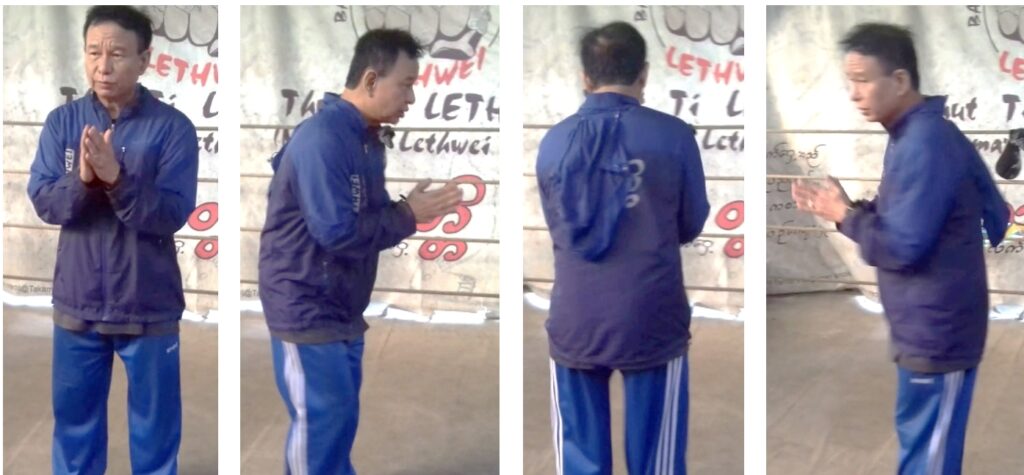
Academy Menu
Module Menu
Module 1 Lessons
Techniques
Tactics
Culture
Knowledge
Review
Culture
Let Oat Chi
Learning Objectives
At the completion of this lesson including review, the instructor candidate will be able to:
- Describe the meaning of the Let Oat Chi
- Identify when and where the Let Oat Chi is given.
- Demonstrate the Let Oat Chi.
Overview
Respect is of utmost importance in Lethwei. The showing of respect in Lethwei is performed by placing the hands together in prayer position and slightly bowing the head. This practice is termed “Let Oat Chi”. It is also a common practice among other Southeast Asian combat sports and martial arts.
The Let Oat Chee is given as a sign of respect between Lethwei fighters, students, and instructors. The Let Oat Chi is often used as a respectful greeting initiated when meeting other people. It is also used as a way to demonstrate respect to Lethwei Saya, training partners, and training spaces. It may also be shown when apologizing.
The Let Oat Chi is also performed at the beginning and end of fights. Fighters perform the Let Oat Chi to each of the four directions to show respect to his opponent, the audience, judges, and referees. It is a essential part of the fighter’s dance or “Lethwei Yay”.
Key Concepts
- The Let Oat Chi is a sign of respect.
- The Let Oat Chi should be shown to all.
- The Let Oat Chi is performed by placing the hands at chest level in the open-handed prayer position.
Instructional Media

Developmental Practice
- Practice the Let Oat Chi using a mirror or video for feedback.
- Practice the Let Oat Chi with a partner.
- Perform the Let Oat Chi in the appropriate situations.
Review
- Explain the meaning and purpose of the Let Oat Chi.
- Demonstrate the Let Oat Chi.
Instructor Level 1 Assessment and Review
Knowledge of and ability to perform the Let Oat Chi required for the Thut Ti Lethwei Global Instructor Level 1 (Saya Dit) Pathway. During the official Instructor Level 1 assessment and review, Instructor Candidates may be asked to describe and/or demonstrate the Let Oat Chi.
Thut Ti Lethwei Global Academy Disclaimer
The information provided on Thut Ti Lethwei Global Academy (lethwei.net) is intended for general informational and educational purposes only. The content on this Website is not intended as a substitute for instruction or direction from a professional combat sports coach or martial arts instructor. The content is also not intended as a substitute for medical direction, advice, diagnosis, or treatment from a health care professional. Always seek the advice of your physician or other qualified health provider with any questions you may have regarding a medical condition or th e safety of participating in any physical activity.
Not Medical Advice: The content on this Website is not intended to be a substitute for professional medical advice, diagnosis, or treatment. Always seek the advice of your physician or other qualified health provider with any questions you may have regarding a medical condition.
Consult a Professional: It is essential to consult with a healthcare professional before starting any new activity program, diet, or exercise routine. Your individual training goals should be discussed with a qualified healthcare provider who can provide personalized recommendations.
Assumption of Risk: Participation in physical activity and exercise carries inherent risks, and by using the information provided on this Website, you acknowledge and voluntarily assume these risks. Always exercise caution and common sense when engaging in physical activities.
Accuracy of Information: While we strive to provide accurate and up-to-date information, the content on this Website may not always reflect the most current research or medical guidelines. We do not guarantee the accuracy, completeness, or timeliness of the information presented.
Responsibility: You are responsible for your health and safety when engaging in any combat sport, martial art, or fitness program, individual exercise, or dietary practice discussed on this Website. Thut Ti Lethwei Global Academy, its authors, contributors, and affiliates disclaim any liability for any injury, loss, or damage incurred as a result of the use or reliance on the information provided on this Website.
Changes to Disclaimer: Thut Ti Lethwei Global Academy reserves the right to modify or update this disclaimer at any time without prior notice. It is your responsibility to review this disclaimer periodically for any changes.
By using Thut Ti Lethwei Global Academy website, you agree to the terms of this disclaimer. If you do not agree with these terms, please refrain from using this website.
